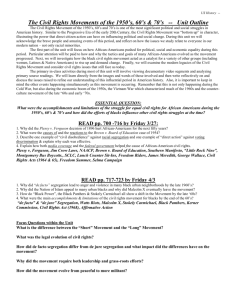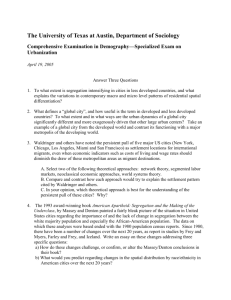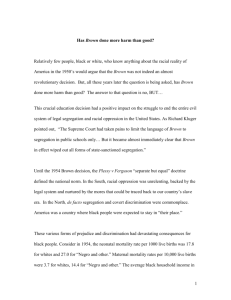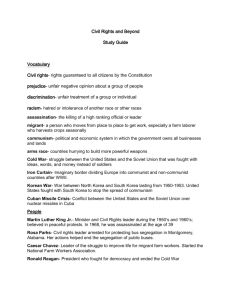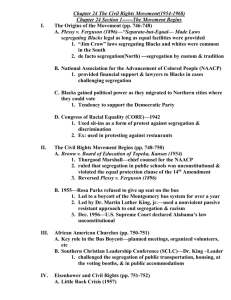Segregation and Stratification
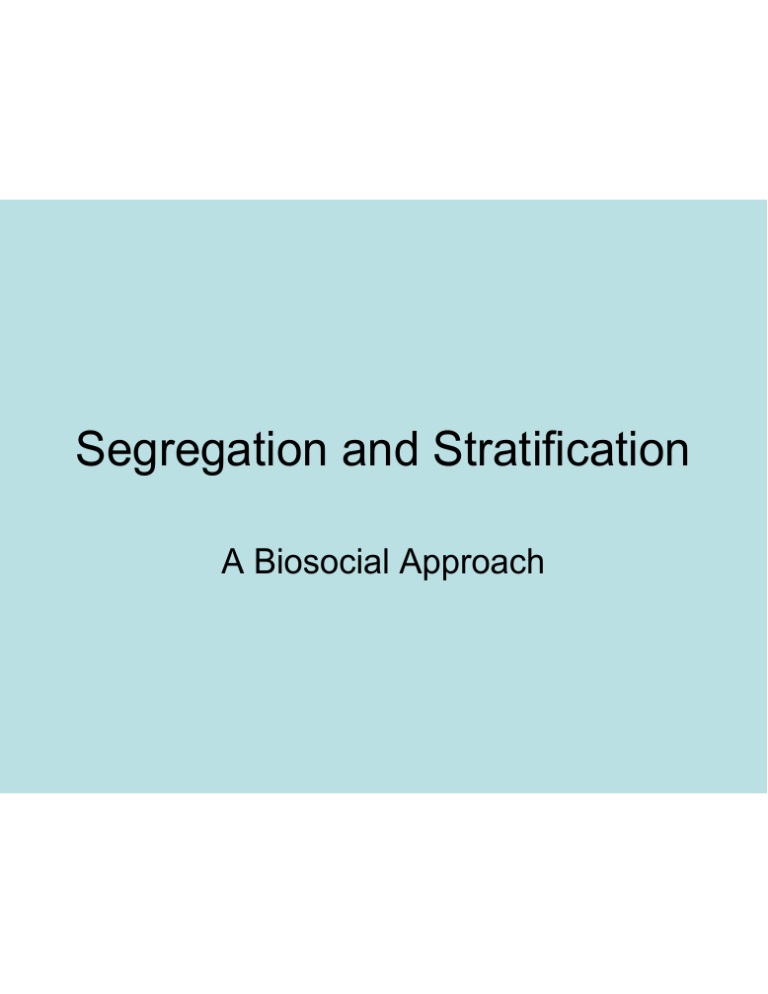
Segregation and Stratification
A Biosocial Approach
Figure 1. Level of segregation experienced by African Americans in 2000.
Source: Iceland et al. 2002
40.5
41.1
Hypersegregated Highly Segregated Low-Moderately Segregated 18.4
Figure 2. Segregation experienced by URBAN African Americans in 2000.
Source: Iceland et al. 2002
31.1
47.5
Hypersegregated Highly Segregated Low-Moderately Segregated 21.3
100 90 80 70 30 20 10 0 60 50 40
Figure 3. Trends in black-white residential segregation for hypersegregated metropolitan areas 1980-2000. Source: Iceland et al. 2002
Chicago Cleveland Detroit Milwaukee Newark Philadelphia All Hypersegregated 1980 1990
Year
2000
Figure 4. Degree of Black-White segregation in hypersegregated metro areas of the U.S. compared with Metro Areas in South Africa Under Apartheid.
Sources: Christopher 1993; Iceland 2003
100 90 80 70 60 50 40 30 20 10 0 So uth A fri can Metr o A reas De troi t M ilw aukee Ch ica go Ne wa rk Cl ev eland Phi US la de Hy lph pe ia rs eg re gate d M etr o Area s
Metropolitan Area
80 70 60 50 40 30 20 10 0
Figure 5. Segregegation of Blacks, Latinos, and Asians from Whites by income in 1990. Source: Massey and Fischer 1999
<$15,000 $15,000-$34,999 $35,000-$49,999
Income Category
$50,000+ Black Latino Asian
60 50 40 30 20 10 0 57.1
Figure 6. Ideal neighborhood desired by Whites and Blacks in 2000.
Source: Charles 2003
16.8
12.8
13.3
30.3
42 14.5
13.1
Whites Blacks
Group
% White %Black % Hispanic % Asians
30 25 20 15 10 5 0
Figure 7. Preference for all in-group and no-outgroup neighborhoods in 2000.
Source: Charles 2003
24.7
20.3
6.5
9.2
Whites Blacks
Group
All Ingroup No Outgroup
Figure 8. Explaining White Preferences for White Neighbors.
Source: Charles 2003
0.5
0.45
0.4
0.35
0.3
0.25
0.2
0.15
0.1
0.05
0 0.041
Perceived Class Differences 0.429
Racial Stereotyping
White Perceptions
Stereotyping of Blacks: Intelligence Laziness Violence Family Fairness 0.142
Ingroup Attachment
Figure 9. Explaining White Avoidance of Black Neighbors Source: Charles 2003
0.45
0.4
0.35
0.3
0.25
0.2
0.15
0.1
0.05
0 0.056
Perceived Class Differences 0.39
Racial Stereotyping
White Perceptions
Stereotyping of Blacks: Intelligence Laziness Violence Family Fairness 0.091
Ingroup Attachment
Figure 10. Percentage Gaining Access to Rental Units and Percentage Having Credit Raised as an Issue, Philadelphia 2000. Source: Massey and Lundy 2001.
30 20 10 0 80 70 60 50 40 White Middle Class English Black Accented English
Linguistic Style Achieved Access
Male Female
Credit Problems Raised
Female Male Black English Vernacular
70 20 10 0 40 30 60 50
Figure 11. Effect of racial segregation on concentration of Black poverty: simulation results for city of 128,000 inhabitants that is 25% black and has class segregation.
Source: Massey 1990
Zero Low High
Level of Black-White Segregation
Total 20% 30%
65 60 55 50 90 85 80 75 70
Figure 12. How segregation increases exposure to major crimes (murder, rape, assault, robbery, burglary, larceny, autho theft).
Source: Massey 2001.
Zero Low
Level of segregation
High Total 20% 30%
25 20 15 10 5 0 40 35 30
Figure 13. Percentage of freshmen at selective schools growing up in segregated schools and neighborhoods. Source: Massey et al. 2003
Neighborhoods Schools 37.1
0.7
Whites 0.4
0.6
Asians 0.6
Group
23.6
Latinos 20 Blacks 22.2
5 0 15 10 25 20 35 30
Figure 14. Exposure of freshmen at selctive schools to school and neighborhood disorder while growing up. Source: Massey et al. 2003
31.65
18.48
18.26
19.53
25.38
Whites Asians Integrated Mixed Segregated
Group and Segregation Level Experienced by Blacks and Latinos
Figure 15. Exposure of freshmen at selctive schools to school and neighborhood iolence while growing up. Source: Massey et al. 2003
5 0 15 10 30 25 20 10.37
Whites 10.9
11.77
18.07
25.97
Asians Integrated Mixed Segregated
Group and Segregation Level Experienced by Blacks and Latinos
3.1
Figure 16. Effect of segregation on grade point earned by African Americans during first three terms of freshman year. Source: Massey and Fischer 2003.
3.05
3
ß = -.171
2.95
2.9
0 0.1
0.2
0.3
0.4
0.5
0.6
0.7
Average Minority Proportion in Schools and Neighborhoods
0.8
0.9
1
Table 1. Reduced-form model estimating effect of social and economic background on grade point earned during first three terms of college or university.
Source: Massey and Fischer 2003 Independent Variables B SE
Race/Ethnicity
White (reference) --- --- Asian Latino Black
Segregation
Average While Growing Up
Demographic Background
Foreign Born Parent -0.011
-0.145*** -0.262*** -0.028
0.016
0.023
0.030
0.027
0.035
0.016
0.021
0.002
0.019
0.009
Two Parent Family Siblings under 18
Socioeconomic Status
Education of Parents No College Degrees (reference) One College Degree Two College Degrees One Advanced Degree Two Advanced Degrees Economic Status Home Value (000) Ever on Welfare Income>$75,000
Correlates of Segregation
School Quality Academic Preparation Social Preparation Psychological Preparation Exposure to Disorder Exposure to Violence --- 0.002
0.071** 0.086*** 0.153*** -0.017
-0.010
0.018
0.074*** 0.003*** -0.395*** 0.256*** 0.167
-0.527*** --- 0.019
0.024
0.020
0.023
0.035
0.023
0.024
0.046
0.001
0.065
0.062
0.110
0.126
Intercept R 2 3.183*** 0.287
Number of Cases 3,920
Allostasis: *The tendency for organisms to maintain stability through change *Occurs through a delicate interaction between the brain, the endocrine system, and the immune system *when a person perceives an external threat, a brain organ known as the hypothalamus triggers an allostatic response.
-hypothalamus signals adrenal glands to release adrenaline -accelerates heartbeat -constricts blood vessels to skin -expands flow of blood to internal organs -dilates bronchial tubes -triggers release of fibrogen into blood (clotting) -releases glucose and fatty acids from stored fats (glycogen) -signals brain to produce endorphins
-hypothalamus simultaneously signals pituitary to release adrenocorticotropic hormone -causes adrenal glands to secrete cortisol into the blood. -works to replace energy stores depleted by adrenaline -converts food into glycogen and fat -promotes conversion of muscle protein to fat -blocks insulin from taking up glucose -causes loss of minerals from bones -changes texture of white blood cells to make them “stickier”
*allostatic response is nature’s way of maximizing an organism’s resources to meet an immediate, short-term threat -long-term functions such as building and maintaining muscle, bone, and brain cells are temporarily sacrificed -put more energy into the bloodstream for evasive or aggressive action -mammalian allostatic systems designed for infrequent and sporadic use -but unlike most mammals, humans are capable of keeping the HPA axis turned on indefinitely -can experience stress from *ideas * in addition to immediate threats
Allostatic Load
*Results whenever stress response is triggered repeatedly or chronically *As when someone is compelled by socioeconomic circumstances or racial discrimination to live in a dangerous environment *inhabitants of such settings not only experience an allostatic response when they perceive dangers directly, *also when they anticipate them mentally—when they imagine threatening events that might occur or when they recall past traumas
Consequences of Allostatic Load for Bodily Systems *cardiovascular system: -elevated adrenaline levels increase blood pressure to raise the risk of hypertension -elevated fibrogen levels increase the propensity for blood to clot and raise the risk of thrombosis -the build-up of “sticky” white blood cells causes the formation of arterial plaques that contribute to atherosclerosis -elevated cortisol levels cause the production of excess glycogen and fat, to raise the risk of obesity
-the suppression of insulin production leads to excessive blood sugar and increases the risk of Type II diabetes -chronically elevated adrenaline disrupts the functioning of vagal nervous system, which slows heart and reduces tension -raises the likelihood of impulsive behaviors associated with a Type A personality -Type A persons exacerbate allostatic load by making poor coping choices: smoking taking drugs drinking alcohol
*immune system:
-elevated of illness and infection -elevated cortisol overstimulates the immune system and goads it into attacking targets that normally don’t pose \ a threat -leads to the expression of inflammatory disorders -asthma -autoimmune diseases -multiple sclerosis -arthritis -Type I diabetes
*brain system
-hippocampus is responsible for consolidation and storage of memory -rich in cortisol receptors -stressful events are important to remember -elevated cortisol causes receptors to become saturated -leads to atrophy of hippocampus -undermines both short- and long-term memory
-excessive cortisol also interferes with the operation of excitatory neurotransmitters -such as glutamate -inhibits long-term potentiation of neural synapses -fundamental neurological event of learning
-hippocampus also plays an essential in shutting off the
HPA axis, so that damage to it creates a vicious cycle:
-excessive cortisol causes shrinkage of hippocampus -causes less inhibition of cortisol production -causes more shrinkage -leads to dendritic remodeling -neurons become shorter and sprout fewer branches -suppresses neurogenesis, -creation of new neurons
Leads to Biosocial Model of Health and Cognition: *There is a causal path between segregation, stressful neighborhoods, allostatic load, and compromised health and cognitive outcomes Segregation-->Stressful Neighborhoods-->Allostatic Load-->Outcomes *what is needed to confirm the links in this chain of events is a dataset that connects individuals and their characteristics to measures of allostatic load and to neighborhood stress *Adolescent Health Survey
Neighborhood Conditions at Waves I, II, and III School Conditions at Wave I and II Total Cortisol at Wave III Health Status on Waves I and II Health Outcomes at Wave III Cognitive Outcomes at Wave III Cognitive Status on Wave I
Prejudice Against Biosocial Theories in Social Science Letter from Editor of Social Science Journal with Instructions for Review: “Downplay the speculative biosocial explanation of the findings. This is a ‘red flag’ to reviewers...” Emphasis in original.

